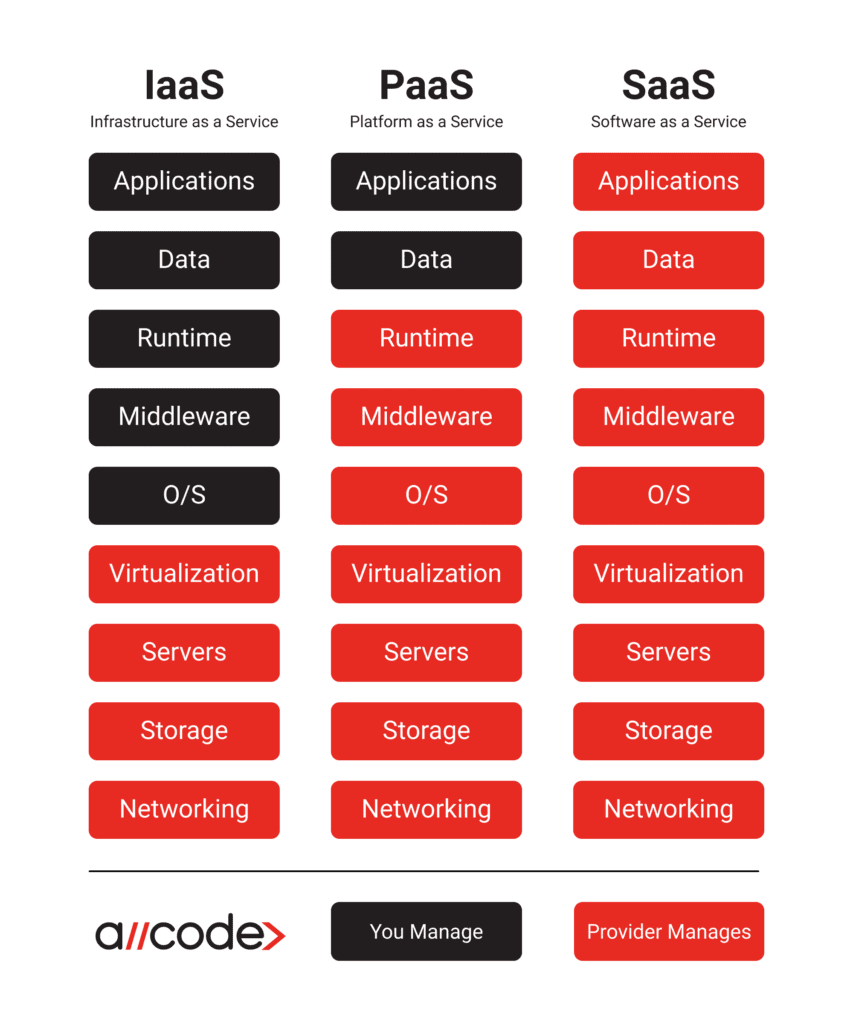Getting the most out of IaaS, PaaS, and SaaS

This blog post provides insight into the fundamentals of IaaS, SaaS, and PaaS, which will help you make an informed decision for your business.
IaaS, PaaS, and SaaS are cloud computing services designed for companies to boost performance and save money. Before these three models existed, companies had to host and manage their own software and applications with on-premises servers.
It’s important to research how these three services differ in order to choose the optimal model for your business.
Infrastructure as a Service (IaaS)
Infrastructure as a Service (IaaS) is the delivery of compute, network, and storage resources over the internet on a pay-as-you-go basis. With IaaS, the user can scale resources up or down on-demand, eliminating the need for unnecessary “owned” infrastructure that requires up-front payment and maintenance.
How IaaS Architecture Works
The cloud provider hosts the infrastructure components, which include the data center, servers, storage, and networking hardware with accommodating services. These services include monitoring, log access, detailed billing, and security, which help the end-user automate important infrastructure tasks.
Customers can access resources and services through internet-accessible virtual machines (VMs), which can track costs, manage disaster recovery, monitor performance, and more. With VMs, users can install operating systems, deploy databases, create storage buckets for workloads and backups, install the enterprise workload, and more.
Common use Cases
Test and development: Quickly set up test and development environments
Website hosting: Benefit from cheaper website hosting
Storage, backup, and recovery: Handle unpredicted storage needs and simplify planning for recovery systems
Big data analysis: Provides horsepower for large amounts of data
IaaS Benefits
Pay-as-you-go: End-users billed only for what they use — never pay up-front
Speed: Provision small to large workloads in minutes and hours, instead of days and weeks
Increased time: Focus on other essential business aspects — the provider maintains the infrastructure
Performance: Provider’s servers span the globe, reducing latency
Platform as a Service (PaaS)
PaaS is a cloud-based development and deployment environment that allows you to deliver applications with a pay-as-you-go model. With PaaS, your development team can develop, test, deploy, and manage builds faster and more cost-effectively.
In addition to the IaaS offerings (servers, data centers, etc.), PaaS includes middleware, development tools, database management systems, and more. Platform as a Service is designed to support the entire web application lifecycle, including building, testing, deploying, managing, and updating.
How PaaS Architecture Works
The provider hosts all of the components at their data center, allowing you to pay for resources as they are needed. The user will control the deployment, while the cloud provider delivers the servers, storage systems, networks, operating systems, and databases.
Common use Cases
API configuration and management: Develop, operate, manage, and secure APIs and microservices
Internet of Things (IoT): Support a variety of application environments, programming languages, and tools used for IoT deployments
Business analytics: Tools you use to evaluate your data — for insights that lead to informed decisions
PaaS Benefits
Reduced Costs: No capital expenditures
Faster Time to Market: Utilize the cloud provider’s services and resources to begin development immediately
Scalability: Scale up or down as needed
Frequent Updates: Automatic updates to be sure that users have the current tools
Software as a Service (SaaS)
Software as a Service (SaaS) is the delivery of cloud-based applications on the internet. SaaS eliminates the need to download and install apps; by contrast, users can access these applications through a web browser.
Software as a Service is the most widely used cloud application service on the market. Examples of a SaaS app are email, calendars, and office communication tools like Slack.
How SaaS Architecture Works
The user pays for access to an app, which is stored online. The provider will host and manage the data center where the infrastructure, middleware, app software, and app data are located, allowing you to deploy faster and with a minimal upfront cost.
SaaS Benefits
No initial costs: Monthly or yearly subscription with a pay-as-you-go model for additional services
Availability: Access SaaS application from anywhere, on any device with an internet connection
Easy integration: Easily integrate with pre-existing software solutions
Security: Provider stores data on servers around the world, offering automatic backups
Cloud Providers
Cloud providers help you make use of IaaS, PaaS, and SaaS. Here are our top 5 cloud service providers:
AllCode: Cloud Computing Experts
We are experts in cloud computing and have helped many clients identify an optimal solution for their organizations. If you have any questions, reach out to us and we will help you decide which services are best for you.
Get In Touch
